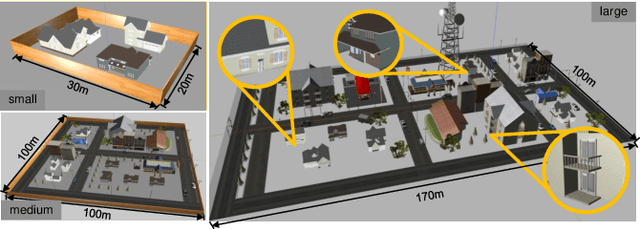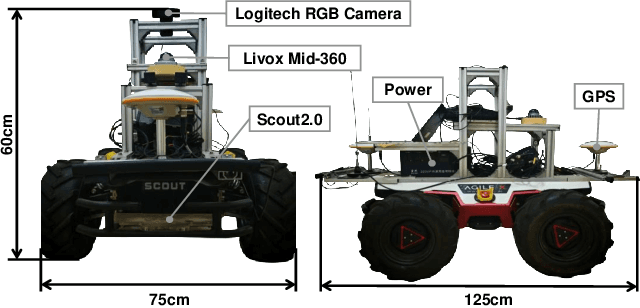Guyue Zhou
TopoDiffuser: A Diffusion-Based Multimodal Trajectory Prediction Model with Topometric Maps
Aug 01, 2025Abstract:This paper introduces TopoDiffuser, a diffusion-based framework for multimodal trajectory prediction that incorporates topometric maps to generate accurate, diverse, and road-compliant future motion forecasts. By embedding structural cues from topometric maps into the denoising process of a conditional diffusion model, the proposed approach enables trajectory generation that naturally adheres to road geometry without relying on explicit constraints. A multimodal conditioning encoder fuses LiDAR observations, historical motion, and route information into a unified bird's-eye-view (BEV) representation. Extensive experiments on the KITTI benchmark demonstrate that TopoDiffuser outperforms state-of-the-art methods, while maintaining strong geometric consistency. Ablation studies further validate the contribution of each input modality, as well as the impact of denoising steps and the number of trajectory samples. To support future research, we publicly release our code at https://github.com/EI-Nav/TopoDiffuser.
UniLegs: Universal Multi-Legged Robot Control through Morphology-Agnostic Policy Distillation
Jul 30, 2025Abstract:Developing controllers that generalize across diverse robot morphologies remains a significant challenge in legged locomotion. Traditional approaches either create specialized controllers for each morphology or compromise performance for generality. This paper introduces a two-stage teacher-student framework that bridges this gap through policy distillation. First, we train specialized teacher policies optimized for individual morphologies, capturing the unique optimal control strategies for each robot design. Then, we distill this specialized expertise into a single Transformer-based student policy capable of controlling robots with varying leg configurations. Our experiments across five distinct legged morphologies demonstrate that our approach preserves morphology-specific optimal behaviors, with the Transformer architecture achieving 94.47\% of teacher performance on training morphologies and 72.64\% on unseen robot designs. Comparative analysis reveals that Transformer-based architectures consistently outperform MLP baselines by leveraging attention mechanisms to effectively model joint relationships across different kinematic structures. We validate our approach through successful deployment on a physical quadruped robot, demonstrating the practical viability of our morphology-agnostic control framework. This work presents a scalable solution for developing universal legged robot controllers that maintain near-optimal performance while generalizing across diverse morphologies.
DISCOVERSE: Efficient Robot Simulation in Complex High-Fidelity Environments
Jul 29, 2025Abstract:We present the first unified, modular, open-source 3DGS-based simulation framework for Real2Sim2Real robot learning. It features a holistic Real2Sim pipeline that synthesizes hyper-realistic geometry and appearance of complex real-world scenarios, paving the way for analyzing and bridging the Sim2Real gap. Powered by Gaussian Splatting and MuJoCo, Discoverse enables massively parallel simulation of multiple sensor modalities and accurate physics, with inclusive supports for existing 3D assets, robot models, and ROS plugins, empowering large-scale robot learning and complex robotic benchmarks. Through extensive experiments on imitation learning, Discoverse demonstrates state-of-the-art zero-shot Sim2Real transfer performance compared to existing simulators. For code and demos: https://air-discoverse.github.io/.
An Real-Sim-Real (RSR) Loop Framework for Generalizable Robotic Policy Transfer with Differentiable Simulation
Mar 13, 2025Abstract:The sim-to-real gap remains a critical challenge in robotics, hindering the deployment of algorithms trained in simulation to real-world systems. This paper introduces a novel Real-Sim-Real (RSR) loop framework leveraging differentiable simulation to address this gap by iteratively refining simulation parameters, aligning them with real-world conditions, and enabling robust and efficient policy transfer. A key contribution of our work is the design of an informative cost function that encourages the collection of diverse and representative real-world data, minimizing bias and maximizing the utility of each data point for simulation refinement. This cost function integrates seamlessly into existing reinforcement learning algorithms (e.g., PPO, SAC) and ensures a balanced exploration of critical regions in the real domain. Furthermore, our approach is implemented on the versatile Mujoco MJX platform, and our framework is compatible with a wide range of robotic systems. Experimental results on several robotic manipulation tasks demonstrate that our method significantly reduces the sim-to-real gap, achieving high task performance and generalizability across diverse scenarios of both explicit and implicit environmental uncertainties.
OpenBench: A New Benchmark and Baseline for Semantic Navigation in Smart Logistics
Feb 13, 2025



Abstract:The increasing demand for efficient last-mile delivery in smart logistics underscores the role of autonomous robots in enhancing operational efficiency and reducing costs. Traditional navigation methods, which depend on high-precision maps, are resource-intensive, while learning-based approaches often struggle with generalization in real-world scenarios. To address these challenges, this work proposes the Openstreetmap-enhanced oPen-air sEmantic Navigation (OPEN) system that combines foundation models with classic algorithms for scalable outdoor navigation. The system uses off-the-shelf OpenStreetMap (OSM) for flexible map representation, thereby eliminating the need for extensive pre-mapping efforts. It also employs Large Language Models (LLMs) to comprehend delivery instructions and Vision-Language Models (VLMs) for global localization, map updates, and house number recognition. To compensate the limitations of existing benchmarks that are inadequate for assessing last-mile delivery, this work introduces a new benchmark specifically designed for outdoor navigation in residential areas, reflecting the real-world challenges faced by autonomous delivery systems. Extensive experiments in simulated and real-world environments demonstrate the proposed system's efficacy in enhancing navigation efficiency and reliability. To facilitate further research, our code and benchmark are publicly available.
Locate n' Rotate: Two-stage Openable Part Detection with Foundation Model Priors
Dec 17, 2024Abstract:Detecting the openable parts of articulated objects is crucial for downstream applications in intelligent robotics, such as pulling a drawer. This task poses a multitasking challenge due to the necessity of understanding object categories and motion. Most existing methods are either category-specific or trained on specific datasets, lacking generalization to unseen environments and objects. In this paper, we propose a Transformer-based Openable Part Detection (OPD) framework named Multi-feature Openable Part Detection (MOPD) that incorporates perceptual grouping and geometric priors, outperforming previous methods in performance. In the first stage of the framework, we introduce a perceptual grouping feature model that provides perceptual grouping feature priors for openable part detection, enhancing detection results through a cross-attention mechanism. In the second stage, a geometric understanding feature model offers geometric feature priors for predicting motion parameters. Compared to existing methods, our proposed approach shows better performance in both detection and motion parameter prediction. Codes and models are publicly available at https://github.com/lisiqi-zju/MOPD
Bridging the Resource Gap: Deploying Advanced Imitation Learning Models onto Affordable Embedded Platforms
Nov 18, 2024



Abstract:Advanced imitation learning with structures like the transformer is increasingly demonstrating its advantages in robotics. However, deploying these large-scale models on embedded platforms remains a major challenge. In this paper, we propose a pipeline that facilitates the migration of advanced imitation learning algorithms to edge devices. The process is achieved via an efficient model compression method and a practical asynchronous parallel method Temporal Ensemble with Dropped Actions (TEDA) that enhances the smoothness of operations. To show the efficiency of the proposed pipeline, large-scale imitation learning models are trained on a server and deployed on an edge device to complete various manipulation tasks.
ActiveSplat: High-Fidelity Scene Reconstruction through Active Gaussian Splatting
Oct 29, 2024Abstract:We propose ActiveSplat, an autonomous high-fidelity reconstruction system leveraging Gaussian splatting. Taking advantage of efficient and realistic rendering, the system establishes a unified framework for online mapping, viewpoint selection, and path planning. The key to ActiveSplat is a hybrid map representation that integrates both dense information about the environment and a sparse abstraction of the workspace. Therefore, the system leverages sparse topology for efficient viewpoint sampling and path planning, while exploiting view-dependent dense prediction for viewpoint selection, facilitating efficient decision-making with promising accuracy and completeness. A hierarchical planning strategy based on the topological map is adopted to mitigate repetitive trajectories and improve local granularity given limited budgets, ensuring high-fidelity reconstruction with photorealistic view synthesis. Extensive experiments and ablation studies validate the efficacy of the proposed method in terms of reconstruction accuracy, data coverage, and exploration efficiency. Project page: https://li-yuetao.github.io/ActiveSplat/.
RGM: Reconstructing High-fidelity 3D Car Assets with Relightable 3D-GS Generative Model from a Single Image
Oct 10, 2024



Abstract:The generation of high-quality 3D car assets is essential for various applications, including video games, autonomous driving, and virtual reality. Current 3D generation methods utilizing NeRF or 3D-GS as representations for 3D objects, generate a Lambertian object under fixed lighting and lack separated modelings for material and global illumination. As a result, the generated assets are unsuitable for relighting under varying lighting conditions, limiting their applicability in downstream tasks. To address this challenge, we propose a novel relightable 3D object generative framework that automates the creation of 3D car assets, enabling the swift and accurate reconstruction of a vehicle's geometry, texture, and material properties from a single input image. Our approach begins with introducing a large-scale synthetic car dataset comprising over 1,000 high-precision 3D vehicle models. We represent 3D objects using global illumination and relightable 3D Gaussian primitives integrating with BRDF parameters. Building on this representation, we introduce a feed-forward model that takes images as input and outputs both relightable 3D Gaussians and global illumination parameters. Experimental results demonstrate that our method produces photorealistic 3D car assets that can be seamlessly integrated into road scenes with different illuminations, which offers substantial practical benefits for industrial applications.
Active Neural Mapping at Scale
Sep 30, 2024



Abstract:We introduce a NeRF-based active mapping system that enables efficient and robust exploration of large-scale indoor environments. The key to our approach is the extraction of a generalized Voronoi graph (GVG) from the continually updated neural map, leading to the synergistic integration of scene geometry, appearance, topology, and uncertainty. Anchoring uncertain areas induced by the neural map to the vertices of GVG allows the exploration to undergo adaptive granularity along a safe path that traverses unknown areas efficiently. Harnessing a modern hybrid NeRF representation, the proposed system achieves competitive results in terms of reconstruction accuracy, coverage completeness, and exploration efficiency even when scaling up to large indoor environments. Extensive results at different scales validate the efficacy of the proposed system.
 Add to Chrome
Add to Chrome Add to Firefox
Add to Firefox Add to Edge
Add to Edge